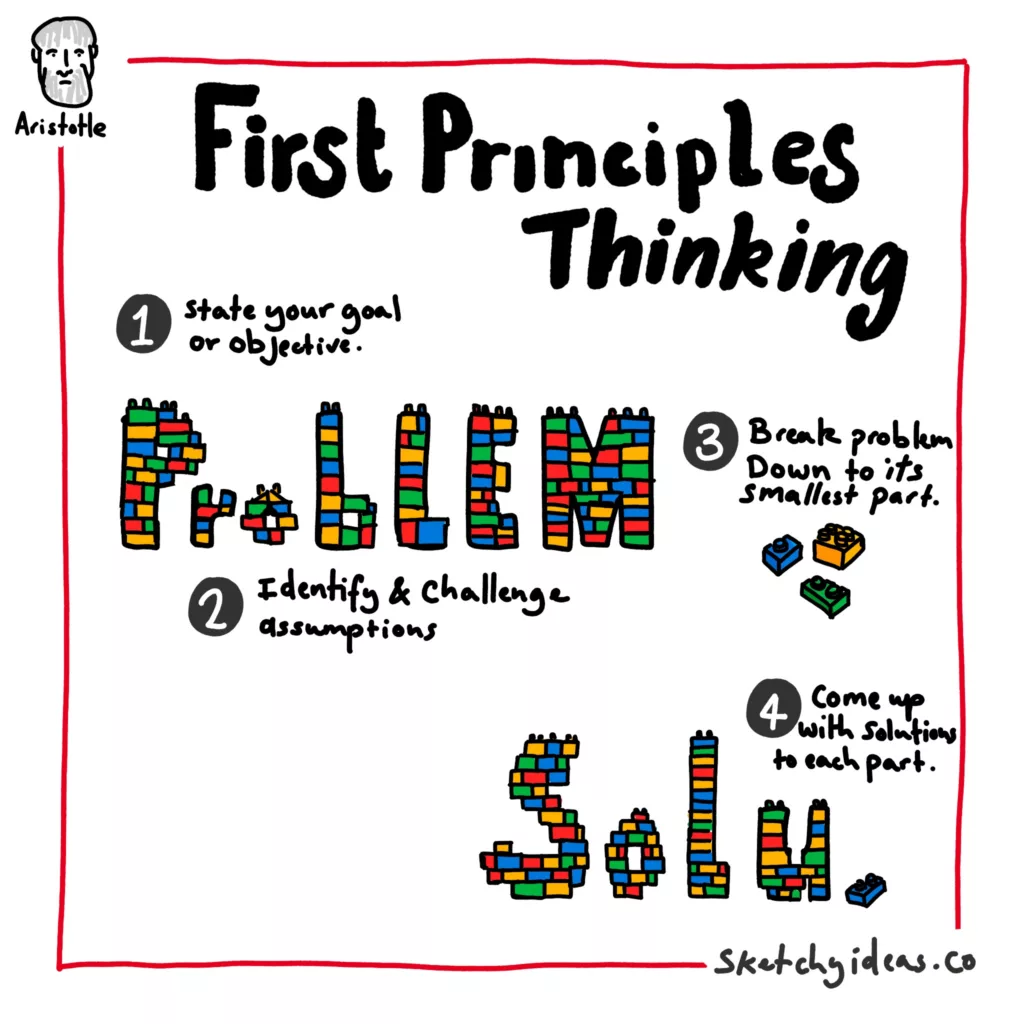How do some inventors manage to come up with completely unique solutions?
Sometimes it’s just an accident, but there are few who use the mental model of first-principles thinking to come up with unique solutions almost on demand.
Let’s explore what it is, why it works so well, and how you can use it for more unique and better solutions.
What is first-principles thinking?

First-principles thinking is a mental model that teaches us to break down a problem into its fundamental elements and build a solution from the ground up. Instead of relying on assumptions or what we’ve been told, we question everything and create a new solution based on the core principles.
By following this approach, we can achieve massive improvements over existing options rather than minor tweaks.
Why it matters
First-principles thinking is critical because it allows us to generate innovative solutions that go beyond the status quo. By breaking a problem down into its most basic components, we can create something truly unique that solves the problem in a way that traditional approaches cannot.
For example, SpaceX founder Elon Musk used first-principles thinking to drastically reduce rocket launch costs.
He identified that the largest cost of space flight was due to discarding rockets after one use. So he focused SpaceX on developing reusable rockets, starting with its boosters. This dramatically reduced their costs and gave SpaceX a distinct advantage.
Instead of relying on pre-existing technology, Musk broke down the fundamental elements of rocket building and built a new solution from scratch.
How to adopt it in your day-to-day life
Here are three simple ways to start incorporating first-principles thinking into your problem-solving process:
State your goal and the problem
You need to know what you are trying to achieve.
The danger is that you might already be misled by prior thinking. For example, “we want to build a better car” has the assumption that people really want a car. It’s better to avoid these terms and look at what they do.
For example, “We want to build a more enjoyable personal transportation vehicle.”
Question assumptions:
Once you have a goal and/or a problem, question everything.
We gravitate to the same solutions as we start with the same assumptions. For example, we assume we need to edit a podcast by looking at and editing the waveform of an audio file but apps like Descript offered a way to edit with a transcript.
The five whys technique can help at this stage.
Break it down:
When you question everything, you may still have an overwhelming problem.
So now you have to break each part down into the most basic components. By addressing these fundamental parts, you can construct a unique solution that addresses the heart of each issue.
Warning
Don’t ignore how these elements interact with each other. There can be knock-on effects and complex interplays between each part.
Build it up:
Once you’ve broken the issue down, you can start building up.
Don’t seek to improve or work with what has gone before, be open to completely new ways of working to solve your problem.
With your core principles in mind, build a new solution from scratch. Don’t rely on pre-existing solutions or what’s already been done.
Evaluate and iterate:
Don’t expect to find a breakthrough straight away.
A novel approach may have novel problems and setbacks. Evaluate what is and isn’t working and iterate to a better solution.
First-principles: the anti-mental model?
Mental models work using analogies and preprepared ways of working to help us find solutions fast.
But first-principles thinking avoids using these models to come up with something truly unique. In a way, that makes it the anti-mental model: the way to approach a problem from a fresh perspective. So does that make mental models useless?
Absolutely not.
By applying diverse models from outside our usual spheres, we can discover unusual insights. And mental models can save us from reinventing the wheel over small and unimportant decisions.
The trick is knowing when you need to apply first-principles thinking and when it’s better to deploy a different model. This is something I’m still learning but my instinct tells me that the more significant a problem, the better it is to start from first principles.
I’d love to hear your insights into this model.

Leave a Reply